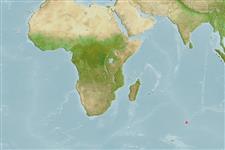>
Perciformes/Scorpaenoidei (Scorpionfishes) >
Scorpaenidae (Scorpionfishes or rockfishes) > Scorpaeninae
Etymology: Neomerinthe: Greek, neos = new + Greek, merinthos, -ou = thread (Ref. 45335); bauchotae: Named in honor of Marie Louise Bauchot in recognition of her numerous contributions to ichthyology..
Environment: milieu / climate zone / depth range / distribution range
Ekologi
marina djupbottenlevande; djupintervall 50 - 510 m (Ref. 35811). Deep-water
Indian Ocean: Saint Paul and Amsterdam Islands.
Size / Vikt / Age
Maturity: Lm ? range ? - ? cm
Max length : 10.1 cm TL hane/ej könsbestämd; (Ref. 35811)
Short description
Morfologi | Morfometri
Taggstrålar i ryggfenan (totalt): 12; Mjukstrålar i ryggfenan (totalt): 10; Taggstrålar i analfenan 3; Mjukstrålar i analfenan: 4 - 5; Ryggkotor: 24. No slit behind the fourth gill arch; posterior margin of the pectoral fin deeply incised between the middle and lower fin rays.
Life cycle and mating behavior
Könsmognad | Reproduktion | Lek | Ägg | Fecundity | Larver
Poss, S.G. and G. Duhamel, 1991. Neomerinthe bauchotae, a new scorpionfish (Scorpaenidae) from Saint Paul and Amsterdam Islands (Southern Indian Ocean), with comments on the limits of the genus. Cybium 15(2):93-102. (Ref. 35811)
IUCN Red List Status (Ref. 130435)
Threat to humans
Traumatogenic
Human uses
Ytterligare information
PopulärnamnsynonymerMetabolikPredatorerEkotoxikologiReproduktionKönsmognadLekSpawning aggregationFecundityÄggEgg development
Age/SizeTillväxtLength-weightLength-lengthLength-frequenciesMorfometriMorfologiLarverLarvdynamikRekryteringAbundansBRUVS
referenserVattenbrukVattenbruksprofilAvelslinjerGenetikElectrophoresesÄrftlighetSjukdomarBehandlingNutrientsMass conversion
MedarbetareBilderStamps, Coins Misc.LjudCiguateraHastighetSimsättGälytaOtolithsHjärnstorlekSyn
Verktyg
Special reports
Download XML
Internet-källor
Estimates based on models
Preferred temperature (Ref.
123201): 3 - 4.3, mean 3.2 °C (based on 3 cells).
Phylogenetic diversity index (Ref.
82804): PD
50 = 0.5002 [Uniqueness, from 0.5 = low to 2.0 = high].
Bayesian length-weight: a=0.01259 (0.00606 - 0.02615), b=3.03 (2.86 - 3.20), in cm total length, based on LWR estimates for this (Sub)family-body shape (Ref.
93245).
Trofisk nivå (Ref.
69278): 3.6 ±0.6 se; based on size and trophs of closest relatives
Resiliens (Ref.
120179): Hög, lägsta populationsfördubblingstid mindre än 15 månader (Preliminary K or Fecundity.).
Fishing Vulnerability (Ref.
59153): Low vulnerability (10 of 100).
